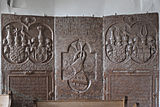St. Peter and Paul (Oberalting)
The Catholic parish church of St. Peter and Paul in Oberalting , a district of the Seefeld municipality in the Upper Bavarian district of Starnberg , was built on the site of several previous buildings in the 15th century in the Gothic style. In the 17th century, the church dedicated to the apostles Peter and Paul was rebuilt in the Baroque style. The church served as the burial place of the Counts of Toerring- Seefeld.
history
The Oberaltingen church is mentioned for the first time in a deed of donation from the year 810. The first church building was probably a wooden church. A building erected in the Romanesque period burned down in 1287. The oldest parts of today's church, the choir and the square substructure of the tower, date back to the 15th century. From 1630 the reconstruction and the Baroque transformation of the church began, initially by the Weilheim master mason Caspar Renner and around 1675 under the direction of Caspar Feichtmayr . The tower was also raised at that time. In the 19th century the west gallery was extended and the patron s box in the choir was removed.
architecture
Exterior construction
The single nave nave is divided into three axes , the retracted choir also has three axes and ends with a five-eighth end . The outer walls of the chancel are supported by double-stepped buttresses. The windows in the choir and nave are rounded at the top and bottom. The smaller upper windows in the choir illuminate the upper sacristy above the choir .
The five-storey bell tower covered with an onion dome rises on the west facade . Glare fields, pointed arched sound arcades and cross-oval openings are cut into the octagonal structure, which is structured by cornices .
The portal is integrated into a sign with a star vault and five keystones on the south side of the church. The lower sacristy is built on the north side of the choir.
inner space
Wall pillars subdivide the nave, which is covered by a needle cap barrel. The choir arch is fluted and stucco decorated with a frame . The choir has an on corbels resting ribbed vault . Also in the basement of the tower, in the room under the west gallery, the Gothic ribbed vault with round, carved keystones has been preserved. The simple stucco decor dates from 1675 and consists of an egg stick , small angel heads and rosettes .
Furnishing
- The pulpit dates from 1723. The basket is decorated with acanthus and the busts of the apostles Peter and Paul, which frame Christ represented as Salvator Mundi . The angel sputtles on the sound cover hold the symbols of the Christian virtues of faith (cross), hope (anchor) and love (heart) in their hands. The double coat of arms refers to Max Cajetan, Count of Toerring, and his wife Adelheid, Marchesa of Canossa.
- The altarpiece , which was created in 1664 and depicts the handover of the keys to Peter, was built into the high altar from 1672. The two figures on the side in polished white represent Saint Joachim and Saint Anna . Like the altar extract with the seated figure of the Father of God, they date from the second half of the 18th century. The smaller figures on the tabernacle are reminiscent of the patron saints of the Augsburg diocese , Saint Ulrich and Saint Afra , to which Oberalting belongs.
- The side altars were erected in 1736. On the left altar is an Altöttinger Madonna, the right altar has a sculpture of St. Catherine , which is attributed to the sculptor Johann Baptist Straub .
- The crucifixion group opposite the pulpit originally comes from the chapel of Seefeld Castle . The two assistant figures, the apostles John and Mary , are dated around 1720/30.
Epitaphs
In the basement of the tower, under the west gallery, there are epitaphs of the Toerring family .
- The oldest gravestone with the coat of arms relief of a swan as a helmet ornament and an inscription in Gothic minuscule reminds of Sweiker von Gundelfingen († 1421).
- The red marble epitaph for Hans von Toerring zu Seefeld und Jettenbach , who died in 1555, depicts the knight kneeling in front of a crucifix with double coats of arms. The signature of the Munich sculptor Caspar Weinhart and the year 1556 are carved on the lower edge.
More tombstones:
- Adelheid, Countess of Toerring zu Seefeld († 1737)
- Ferdinand Freiherr von und zu Toerring auf Seefeld († 1622) and Anna Maria, née Vötter von Gilgen († 1612)
- Eustachius Freiherr von und zu Toerring auf Seefeld († 1615) and Katharina, born von Bembelberg and Hohenburg († 1612)
- Lukretia, Countess of Toerring zu Seefeld († 1755)
- Ulrich Haidt, Count Toerringischer Hofmarksrichter († 1664) and his wife Barbara († 1664)
literature
- Georg Dehio : Handbook of German Art Monuments - Bavaria IV - Munich and Upper Bavaria . 2nd Edition. Deutscher Kunstverlag, Munich 2002, ISBN 3-422-03010-7 , p. 892 .
- Wilhelm Neu (revised by Klaus Kraft and Angelika Rank): Oberalting with Unering and Seefeld, Drößling with Meiling and Delling . Published by the parish of St. Peter and Paul Oberalting, Oberalting 2006.
Web links
Individual evidence
Coordinates: 48 ° 2 '12 " N , 11 ° 13' 8.8" E







